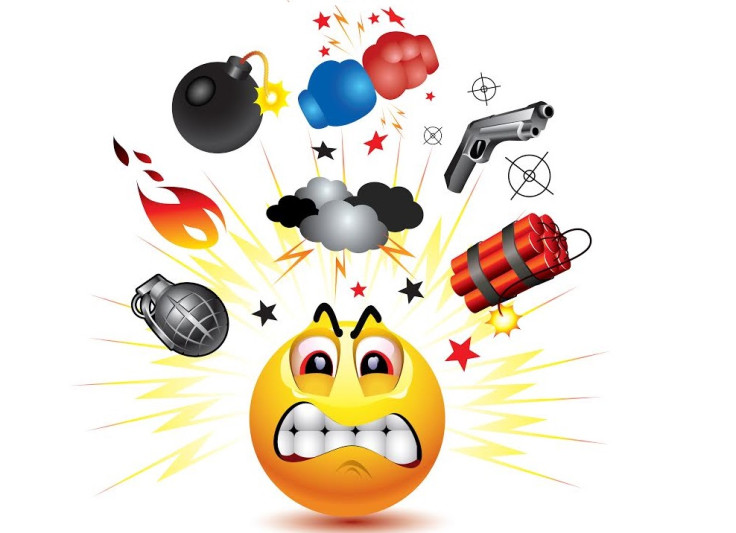When kids are getting arrested, our hypersensitivity about 'threatening' emojis is absurd

Be careful not to let your imagination get the better of you when posting emojis on social media. You might think that you are just playing at being outrageous, but the increasingly intrusive internet police might take another view.
It now seems that an angry emoji can be interpreted as evidence of criminal intent. And even a young child posting threatening emojis can be arrested and charged. That's exactly what happened to a 12-year-old girl in Fairfax, Virginia, who is facing criminal charges for posting knife, gun and bomb emojis on Instagram.
Last December, an official at Lanier Middle School in Fairfax who saw the post interpreted the emojis as a potential threat to the safety of the school and alerted the police. The local police responded swiftly and arrested the girl.
She was charged with threatening the school and computer harassment. Since proceedings against this child are not open to the public it is not clear if this case has been resolved. However, it is unlikely to result in any further action since a spokesman for the local schools has indicated that the alleged threat was deemed as "not credible".
It is difficult to understand what motivates a child to post threatening emojis next to the words "Killing. Meet me in the library Tuesday". The girl's mother stated that the violent emojis were posted in reaction to being bullied in school, and that "she's a good kid" who has "never been in trouble before". She, like many others, believes that the child should never have been charged with a crime.
Numerous commentators have noted that the police are faced with a difficult challenge of deciding how to interpret threatening communications using emojis, which are typically posted in a light-hearted manner. But surely when children allow their fantasy to run riot, authorities can afford to be relaxed and understanding?
Violent fantasies for children serve as a displacement for aggression
Adults need to understand that when a child makes threatening gestures or uses violent words and symbols it has a different meaning than if they were articulated by a grown-up. Research into children's storytelling indicates that often their accounts involve violent conflict, threatening images and aggressive behaviour.
Some adults who listen to the gory details of such stories may draw the conclusion that the young storyteller has an unhealthy predilection for deviant behaviour. Yet on closer inspection it becomes evident that the blood-curdling storytellers know where to draw the line and keep aggression contained within acceptable boundaries.
Throughout the 20<sup>th century there were constant calls to protect children from the supposed toxic effect of violent films, television programmes and videos. However, children have proven to be quite able to distinguish between what they watched and their own reality. As is the case with violent storytelling, horror films can serve as a useful outlet for aggressive impulses. They provide a medium for emotional catharsis.

It is not surprising that children do not simply post smiley faces to one another. Macabre fantasies and violent emojis serve as a displacement for aggression, and are likely to be used frequently in the future. The posting of threatening emojis continues the long established practices of using words and images as an outlet for powerful emotions.
Adults who are pre-occupied by these kind of aggressive messages posted by children online should reflect on the centuries-old practices of young people offline. Children's drawings of badly mutilated dead bodies and of the killing of other people have often shocked adults and teachers. But such exercises in self-expression were invariably harmless and served as testimony to a child's confused and disturbed thoughts.
One fears what earnest 21st century police investigators would make of violent statements and images found in thousands of children's diaries and drawings
Children's journals and diaries have also been full of furious and unrestrained statements about wanting to kill another person or themselves. But the very expression of those sentiments provided a vehicle for releasing powerful emotions which were purely channelled through the medium of a diary.
One fears what earnest 21<sup>st century police investigators would make of violent statements and images found in thousands of children's diaries and drawings. That children now use emojis to express themselves in similar ways should not come as a surprise to the adult world. Grown-ups would do well to take a reality check and not interpret threatening symbols produced by children as anything other than a childish fantasy.
Those who seize upon a threatening emoji as a potential marker for a future psychopath or a mass school-shooter should remember that violent fantasies are common to young people – potential killer and normal child alike. Something has gone seriously wrong when a 12-year-old girl can face criminal charges for posting the wrong kind of emoji online.
Frank Furedi is a sociologist and social commentator. He was formerly Professor of Sociology at the University of Kent in Canterbury. His most recent book is Power of Reading: From Socrates to Twitter.
© Copyright IBTimes 2025. All rights reserved.






















